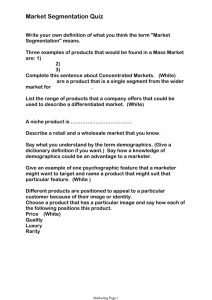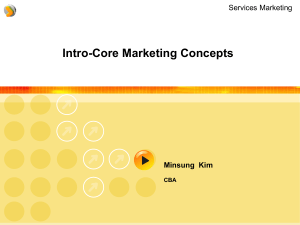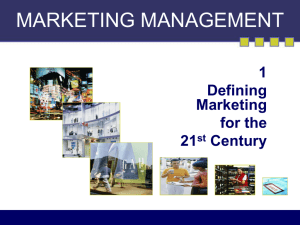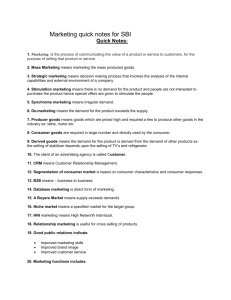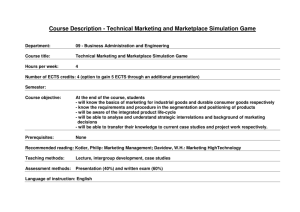of value
advertisement
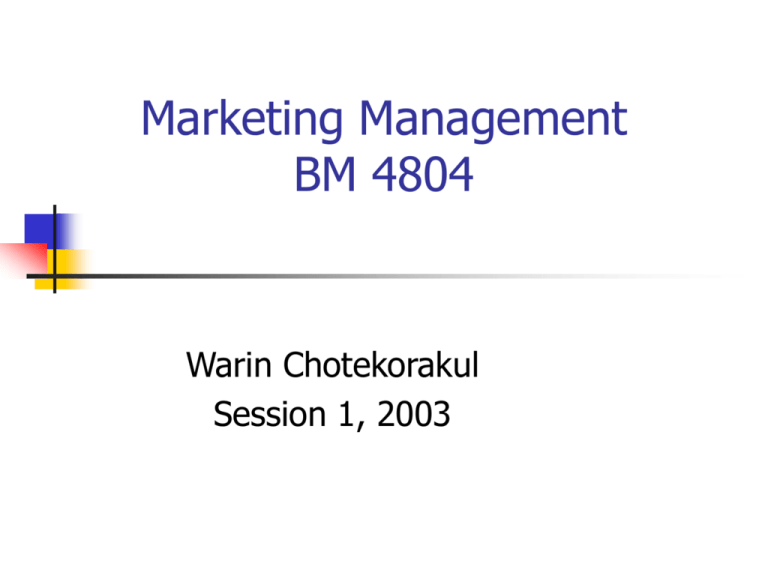
Marketing Management BM 4804 Warin Chotekorakul Session 1, 2003 Ch. 1 Defining marketing for the 21st century The questions that we should be able to respond after completing the chapter: What is the new economy like? What are the tasks of marketing? What are the major concepts and tools of marketing? What orientations do companies exhibit in the marketplace? How are companies and marketers responding to the new challenges? What is the new economy like? What is the old economy? Based on the “Industrial Revolution” and on managing “manufacturing” industries Goal: efficiency Hierarchical management being used What is the new economy like? (2) New economy Based on the “Digital Revolution” and the management of “information” Substantially differentiated, customized, and personalized Less hierarchical management—Why? What are the tasks of marketing? 3 stages that a company might pass: Entrepreneurial marketing Formulated marketing Intrepreneurial marketing Question: Each of the three stages requires the same marketing tasks? Yes What are the tasks of marketing? (2) Marketing is the task of creating, promoting, and delivering goods and services to consumers and businesses. Demand States and Marketing Tasks Negative demand: occurs when the market dislikes the product Marketing Task: to analyze why the market dislikes the product, and how to change the beliefs and attitudes No demand: occurs when target market is unaware of the product Marketing Task: to connect the benefits of the product with the needs Demand States and Marketing Tasks 2 Latent demand: A strong need that cannot be satisfied by any existing product Marketing task: to measure the size of the potential market and develop effective pdt Declining demand: Decreasing demand for the product Marketing task: to reverse the declining demand through creative remarketing Demand States and Marketing Tasks 3 Irregular demand: Demand varies on a seasonal, daily basis Marketing task: to find ways to alter the same pattern of demand called “Synchromarketing” Full demand: Occurs when a company is satisfied with the volume of business Marketing task: to maintain current demand level facing the changing consumer preferences and increasing competition Demand States and Marketing Tasks 4 Overfull demand: Occurs when demand level is higher than a company can handle Marketing task: to find ways to reduce the demand called “Demarketing” : General and Selective demarketing Unwholesome demand: For unwholesome products e.g. handguns, cigarettes, X-rated movies/websites Marketing task: to get people who like these things to give them up What are the major concepts and tools of marketing? Definitions of Marketing: Social: Marketing is a societal process by which individuals and groups obtain what they need and want through creating, offering, and freely exchanging products and services of value with others. Managerial: Marketing is the art of selling products What are the major concepts and tools of marketing? (2) Marketing Management: the ways to achieve desired responses from other parties Definition of Marketing Management The art and science of choosing target markets and getting, keeping, and growing customers through creating, delivering, and communicating superior customer value Core Marketing Concepts Segmentation and Target markets: Segmentation or Market Segmentation is the process of dividing a market into groups whose valuations of products are similar within groups and who differ across those groups Market Segment is a group of actual or potential customers who can be expected to respond in a similar way to a product or service offer Core Marketing Concepts (2) Segmentation and Target markets (2): the process of selecting segments to serve and identifying customers in target segments by evaluating the attractiveness of segments Market Targeting is Target Market is is a market that the company chooses to serve effectively and profitably Core Marketing Concepts (3) Marketplace, Marketspace, and Metamarket: Marketplace is physical (shopping in a store) Marketspace is digital (shopping on the net) Metamarket is a group of complementary pdts and services that are closely related in the minds of consumers but are spread across a diverse set of industries e.g. home ownership market Core Marketing Concepts (4) Marketers and Prospects Needs, Wants, and Demands: Needs are the basic human requirements Wants are specific objects that might satisfy the need Demands are wants plus ability and WTP Censure: marketer cannot create needs, but can influence wants. Core Marketing Concepts (5) Product, Offering, and Brand: Why does a customer buy a product (car)? If so, we can call them as Value Proposition. What is the difference between “product and offering”? Is offering a subset of product? Brand enables a customer to know the offering comes from what company Core Marketing Concepts (6) Value, Cost, and Satisfaction: How do consumers choose among the many products that might satisfy a given need? The guiding concept is value. Value is the consumer’s estimate of the product’s overall capacity to satisfy his or her needs. Value is the combination of Quality, Service, and Price (QSP) or Customer Value Triad Core Marketing Concepts (7) Value, Cost, and Satisfaction (2): How to measure Value? Value = Benefits/Costs Exchange and Transaction: Exchange is the act of obtaining a desired product from someone by offering something in return. Exchange is the defining concept underlying marketing. Core Marketing Concepts (8) Exchange and Transaction (2): A transaction is a trade of values between two or more parties. Two types: Monetary VS Barter transactions Transaction = / Transfer Relationships and Networks: Relationship Marketing: aim to build up L-T, trusting, and “win-win” relationships with customers, distributors, dealers, and suppliers RM brings down costs on transaction and time Core Marketing Concepts (9) Relationships and Networks (2): The final outcome of RM is the building of a unique company asset called a marketing network. Marketing Network consists of the company and its supporting stakeholders. Core Marketing Concepts (10) 3 types of marketing channels: Communication channels: to deliver and receive messages from target buyers Distribution Channels: to display, sell, or deliver the physical products or services to buyer or user Service channels: to facilitate transactions Channels Communication Channels 1. Monologue 2. Dialogue Distribution Channels 1. Warehouse 2. Transportation Vehicle 3. Trade Channels 3.1 Wholesaler 3.2 Retailer 3.3 Distributor 3.4 Agent Service Channels Facilitating Organizations such as banks, Insurance companies Core Marketing Concepts (11) Supply Chain: Describes a longer channel stretching from raw mat to components to final products that are carried to final buyers Competition: Brand Competition Industry competition Form competition Generic competition Core Marketing Concepts (12) Marketing Environment: Task (micro) environment (main actors) Broad (macro) environment Marketing Program/Plan: To achieve the company’s objectives Marketing mix: set of marketing tools used to pursue marketing objectives in the target market Core Marketing Concepts (13) Marketing Program/Plan (2): Robert introduced that the sellers’ 4 Ps correspond to the customers’ 4 Cs Four Ps Product Price Place Promotion Four Cs Customer solution Customer cost Convenience Communication What orientations do companies exhibit in the marketplace? 6 company directions The The The The The The production concept product concept selling concept marketing concept customer concept societal marketing concept 1. The Production concept The concept holds that consumers will favor those products that are widely available and inexpensive. The assumption holds in 2 types of situations: Where the demand for a product exceeds supply (in 3rd World countries) Where the product’s cost is high and has to be brought down through increased productivity to expand the market 2. The Product concept The concept holds that consumers will favor those products that offer the most quality, performance, or innovative features. The companies get little or no customer input, and very often they will not examine competitors’ products. Planned Obsolescence Strategy e.g. Lancer VS Lancer Cedia by Mitsubishi 2. The Product concept (2) The product concept leads to “marketing myopia” (Levitt, 1975) which means managers often view their market from a narrow, product-oriented perspective, and this may result in missed opportunities. For example, railroad management. 3. The Selling concept The concept holds that consumers, if left alone, will ordinarily not buy enough of the organization’s products. Thus, the company must undertake an aggressive selling and promotion effort. For companies with unsought products, or when companies have overcapacity. Inside-out approach 4. The Marketing concept The concept holds that the job is not to find the right customers for your product, but the right product for your customers (outside-in approach). Satisfying needs of the customers 4. The Marketing concept (2) 3 Types of marketing orientation: Reactive market orientation: understanding and meeting customers’ expressed needs Proactive marketing orientation: concentrating on customers’ latent needs Total market orientation: combination of the above two Points to study from Marketing Concept 5 Types of Needs: Stated needs: A fast laptop Real needs: High performance, Accurate result Unstated needs: Good service Delight needs: Mouse and mouse pad Secret needs: Smart, savvy consumers Points to study…(2) 3 types of marketing on basis of countering to customer’s needs: Responsive Marketing Anticipative Marketing Creative Marketing Points to study…(3) Integrated Marketing: all the company’s departments work together to serve the customer’s interests External Marketing: marketing directed at people outside the company Internal Marketing: marketing directed at employees of the company 5. The customer concept Outside-in approach One-to-one marketing To capture a larger (market) share of each customer’s expenditures Question: Is customer share the same idea as market share? 6. The societal marketing concept The concept holds that the organization’s task is to determine the needs, wants, and interests of target markets and to deliver the desired satisfactions more effectively and efficiently than competitors in a way that preserves or enhances the consumer’s and the society’s well-being. e.g., the Body Shop When to Review Marketing Plan Sales decline Slow growth Changing buying pattern Increasing competition Increasing marketing expenditures Company Responses and Adjustment Re-engineering Outsourcing E-commerce Benchmarking Partner-supplier Alliances Market-centered Global and local Decentralized Marketer Responses and Adjustments Relationship marketing Customer lifetime value Customer share Target marketing Individualization Customer database Integrated marketing communication Channel as partner Every employee a marketer Model-based decision Takeaways from Ch.1 The old VS the new economies The marketing tasks (and for diff DD states) Major marketing concepts and tools 6 Types of orientations Company and marketer responses in the new economy
